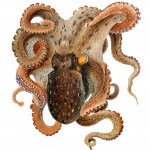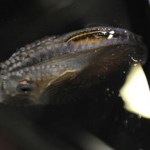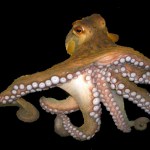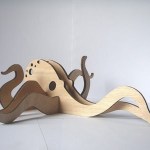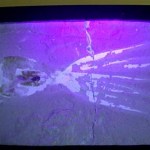octopus
Who could forget the second most popular blog post so far this year. Seeing an octopus walk never gets old!
-------
I came across this amazing video on YouTube showing a species of octopus found in Northern Australia that is adapted to walk on land:
I came across this amazing video on YouTube showing a species of octopus found in Northern Australia that is adapted to walk on land:
Yes, Finding Dory is right about this.
Having multiple hearts isn't as odd as it might seem. Although one might be advised to keep one's brain and one's heart, as well as one or two other organs, separate when making important decisions, a heart and a brain are metaphorical of each other in this regard. Nervous systems can exist and function without brains, but in many animals clumps of neurons known as ganglia concentrate neural function. The same sort of electric and chemical interactions occurring across a network of neurons can have more complex functions when the neurons are grouped…
NOAA image of a possible new species of octopus discovered near Hawaii. Photo credit: AP, NOAA
Scientists from the National Oceanic and Atmospheric Administration (NOAA) think they have discovered a new species of octopus while exploring the ocean floor around Necker Island (near Hawaii). The octopus was found 4,290 meters deep. Interestingly, fins were absent from the pale octopus, which NOAA scientist Michael Vecchione noted was unusual for an octopus living at that depth. Moreover, its suckers were found to be in a single row on each of its arms, as opposed to two rows.…
Speaking of octopuses, the ability for the animals to squeeze through narrow openings has inspired the creation of a new surgical robotic device that can squeeze into a patient's body.
An EU team created STIFFness controllable Flexible and Learnable manipulator for surgical OPerations, dubbed "STIFF-FLOP", made from silicone. Unlike conventional robots used during surgeries, the idea behind STIFF-FLOP is to be able to navigate around organs inside the body and minimize potential damage to healthy tissues. Its movements are controlled by pneumatic actuators. To create stiffness, they…
New research shows how octopus skin is able to respond to variations in light
Could giant freshwater octopuses really be to blame for the many unexplained drownings in Oklahoma's lakes?
Image of female Argonaut. Photo from Cabrillo Marine Aquarium, taken by Gary Florin.
Photo by: Brittany Murray / Staff Photographer Daily Breeze
A rarely seen species of octopus was found this week by fisherman off the coast of San Pedro, California. The baseball-sized female Argonaut (aka: paper nautilus), pictured in the image above, normally lives in tropical and subtropical waters. She is now making a new home in the Cabrillo Marine Aquarium in San Pedro. Not much is known about this mysterious species since they are difficult to maintain in captivity.
They are…
It was July 1976. The nation was busy celebrating its bicentennial, a gallon of gas cost 60 cents, and the Yankees were heading for their first postseason in 12 years, but the real action was at Brookhaven National Laboratory, scene of a life-and-death battle between Spiderman, Doctor Octopus, and the Ghost of Hammerhead.
That's right, The Amazing Spider-Man #158 was set at Brookhaven, as the reader is informed, "on Long Island's thriving North Shore: Usually these quiet buildings are merely devoted to extensive research in the field of atomic energy, but today they are an arena, a…
Here at Thoughtful Animal headquarters, we are conducting series of seven-question interviews with people who are doing or have done animal research of all kinds - biomedical, behavioral, cognitive, and so forth. Interested in how animal research is conducted, or why animal research is important? Think you might want to do some animal research of your own someday? This is the interview series for you.
Dr. Zen Faulkes (website, twitter) is Associate Professor of Biology at the University of Texas-Pan American, where he studies the evolution of behavior and nervous systems, particularly the…
Well, sort of. Ready for the new SETI blog here at Scienceblogs? They launched today.
I don't know if we have to look to the skies to find aliens. We've got some pretty strange terrestrial life around here:
(via @sfriedscientist of Southern Fried Science)
Say you're visiting Los Angeles and you have a sudden craving for Chinese food. Since you are only visiting, you might not be aware that nothing is open past, like, 10pm (not even coffee houses), but you get in your rental car and go driving around in search of your Chinese feast anyway. You try hitting up Panda Express, but no such luck. Of course they're closed. You try the neighborhood Chinese restaurant: closed as well. You get back in the car, and think to yourself "maybe the OTHER Panda Express will be open", but alas, it is not. You are ready to return to the hotel and just go to sleep…
It's amazing how much you can learn about an animal's mind by a simply watching it.
Video 1: Gratuitous video of octopuses never hurt anyone. Maybe this will sate the Pharyngulites.
In the late 1980s, a researcher named Jennifer A. Mather wondered about octopuses' use of spatial memory. This researcher and some volunteers did some skin-diving near Bermuda and observed octopuses going out in search of food. They noticed that sometimes after catching a tasty bit of chow, the octopuses ate out, but sometimes they'd take their snack to go and eat at home. And not only that, but it turned out…
tags: Hooked by an Octopus, animals, zoology, invertebrates, octopus, marine biology, film maker, animal behavior, Mike deGruy, TEDTalks, streaming video
Underwater filmmaker Mike deGruy has spent decades looking intimately at the ocean. A consummate storyteller, he takes the stage at Mission Blue to share his awe and excitement -- and his fears -- about the blue heart of our planet.
TEDTalks is a daily video podcast of the best talks and performances from the TED Conference, where the world's leading thinkers and doers give the talk of their lives in 18 minutes. Featured speakers have…
Cool new report in Current Biology, Defensive tool use in a coconut-carrying octopus:
The use of tools has become a benchmark for cognitive sophistication. Originally regarded as a defining feature of our species, tool-use behaviours have subsequently been revealed in other primates and a growing spectrum of mammals and birds...Among invertebrates, however, the acquisition of items that are deployed later has not previously been reported. We repeatedly observed soft-sediment dwelling octopuses carrying around coconut shell halves, assembling them as a shelter only when needed. Whilst being…
A research team led by Julian Finn of the Museum of Victoria in Melbourne has discovered octopuses using coconut shells as portable protection. Not only do they hide under single halves but will actually pull two halves together and hide inside, like some sort of Super Mario baddie. The video is remarkable.
Using tools means octopuses now join an elite club of wise animals including chimps, dolphins, and Tim Allen.
Thanks to Salem for sending this along.
Octopuses are masters of camouflage that can change their shape, colour and texture to perfectly blend into their environment. But the soft bodies that make them such excellent con artists also make them incredibly vulnerable, should they be spotted. Some species have solved that problem with their fierce intellect, which allows them to make use of other materials that are much harder. The veined octopus, for example, dons a suit of armour made of coconut shells.
The veined octopus (Amphioctus marginatus) lives in sandy, exposed habitats that have little in the way of cover. To protect…
One of the sucky things about viral interest in offbeat art from small vendors is that it always immediately depletes the supply. Like this fabulous minimalist plywood octopus from inthewoods' etsy shop. Sure, you can still get a plywood squirrel with a plywood acorn, but where's the sinister, feverish Cthulhulian majesty in that? Frustrated now!
Via monoscope
by Katie the lowly intern
Just when you started to feel comforted by the surge of popular culture embracing cephalopods on TV, apparel and porn, scientists spoon out a dose of brutal reality. Researchers from University of Melbourne, University of Brussels and Museum Victoria have revealed another terrifying fact about octopuses. It's not enough that they can squirt ink, have beaks, move by jet propulsion, change colors in seconds, turn their eyes to keep their pupils horizontally oriented, have no bones and most horrifically: have eight arms... but give very few hugs*.
The original octo-…
As boneless, gelatinous bags, octopuses rarely find themselves preserved as fossils but just this week it was announced in the journal Palaeontology that three new 95,000,000 year old octopus fossils have been discovered. These are the oldest on record. So what does an octopus fossil look like? Apparently, like something your elementary school child would create in art class when asked to create an octopus fossil.
The precursors to modern octopuses had fins that ran alongside their bodies but these fossils do not. "These are sensational fossils, extraordinarily well preserved' says Dirk…
